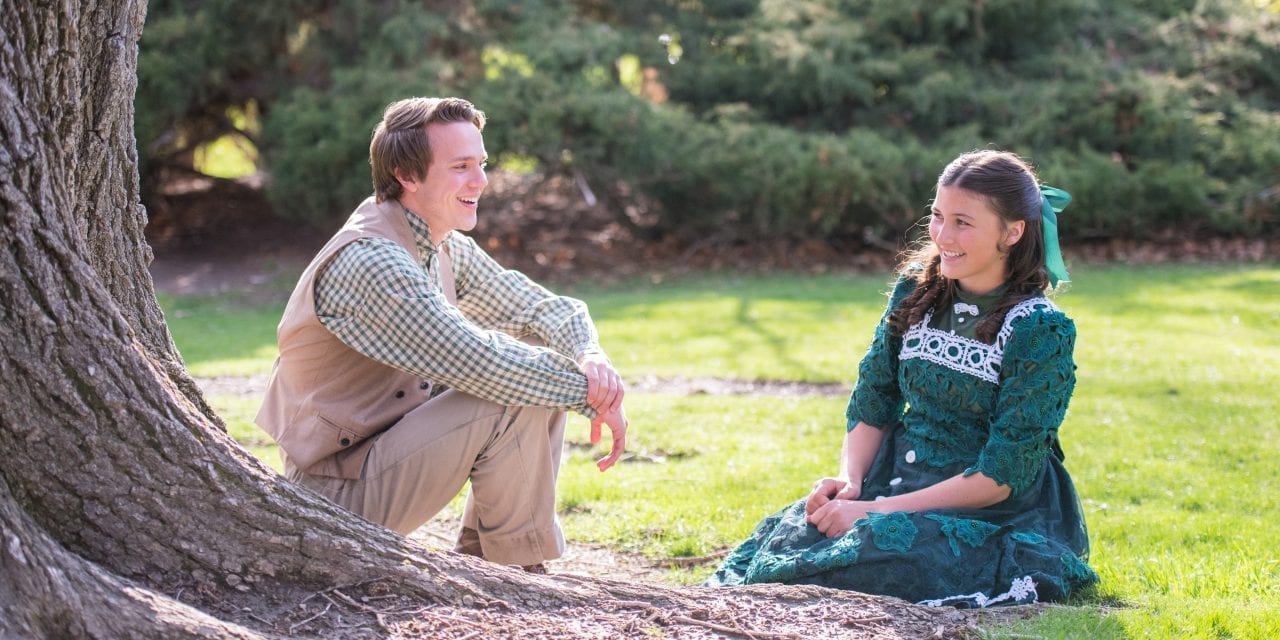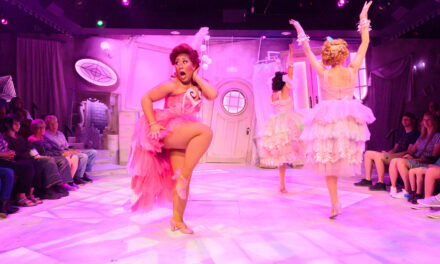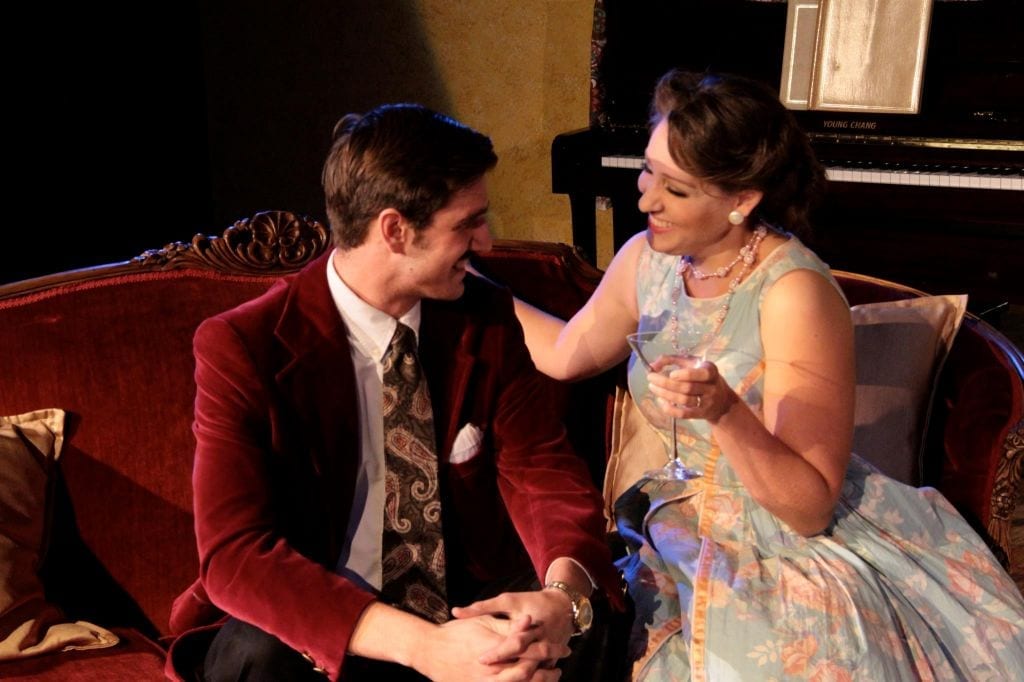OREM — In Tuck Everlasting, Winnie Foster (played by Abigail Scott) is a spunky, adventurous 11-year-old with a wild spirit. Too much tempts her while she is still supposed to be mourning her father’s death. Especially the sweet melody coming mysteriously out of the forbidden woods. One rebellious day, she discovers the Tuck family while playing in these woods. What she doesn’t know is that this family has a secret.

Show closes June 15, 2019.
Directed by David Morgan, this musical adaptation of Natalie Babbit‘s classic novel (with a script by Claudia Shear and Tim Federle, music by Chris Miller, and lyrics by Nathan Tysen) was mounted at Hale Center Theatre Orem. Morgan made good use of the small space by having actors run up and down the stairs, next to the audience, or even climb trees at the front of the stage. Unfortunately, these movements excluded a good part of the audience on stage left. Most of the actors faced forward or towards stage right, making the actors’ emotions and facial expressions difficult to decipher. This being said, Morgan showed his versatility by including small children in the cast and allowing them to play key roles in the production.
The set design by Cole McClure (who was also in charge of sound design and costumes) was brilliant in addressing a variety of scenes throughout the play. One important aspect of the set was the tree at the back of the stage, which provided a backdrop to multiple scenes, but was also an integral part of the musical. Its branches moved to the perfect spot so performers could climb across them and hide behind the leaves that were lowered and raised throughout the show. The highlight of the cast’s use of the set was a tender moment shared between Winnie and Angus Tuck. Angus took the little girl fishing on a picturesque rowboat that floated on a “lake” covered in fog. As the fog filled the floor of the stage, the lights (designed by Cody Swenson) made it appear as though there truly was water filling the room. The boat then began to drift carelessly across this lake, most likely moved about by the famous, rotating circular piece at the center of the stage. Swenson’s lighting design had other memorable moments throughout the play. There were changes in color that clearly displayed different times of day or represented the emotions the actors expressed onstage. The was also a well-planned effect in which the fireflies that danced on the ceiling and around the theater. This small detail that could have easily been overlooked, but enhanced the feeling of a scene taking place out in nature.

Abigail Scott as Winnie Foster and Dallin Suman as Jesse Tuck. Photo by Suzy Oliveira.
Jesse Tuck (played by Dallin Suman) was the poster child for 1800s boyhood. Suman did a great job in portraying a happy-go-lucky 17-year-old who didn’t quite understand the implications of his family’s eternal secret. Suman had an amazing singing voice that harmonized fabulously with the rest of the cast. When joined by Scott out in the woods, Jesse was able to become a friend — not just for Winnie, but for the audience, too. He made me feel as though we were all a part of that moment with him and Winnie. Although around 16 years old, Scott’s acting abilities were well beyond her years, and she showed great emotion throughout the story of the play. For instance, while sitting with Angus in the drifting rowboat, they realistically discussed the many opportunities and challenges of life.
Two memorable performers were Cleveland McKay Nicoll, who played Miles Tuck, and Stephen Kerr, who played the Man in the Yellow Suit. Nicoll was excellent at portraying the older brother: consistently firm, yet loving, with a wonderful vocal range. Nicoll had an amazing solo in the second act of Tuck Everlasting that was reminiscent of Ben Platt. I felt that had Nicoll played a character with more opportunities to sing, he would have been the star of the show. Kerr was an interesting old carnival man, with his gruff, conniving voice and raspy cough that made him the easy-to-spot villain.

Abigail Scott as Winnie Foster. Photo by Suzy Oliveira.
The best character development was portrayed by actor Rex Kocherhans, who played Angus Tuck. Kocherhans played the father figure for everyone in the cast, making him a friendly and approachable individual for Winnie. He started the performance as a seemingly broken recluse, who had one goal in life: to hide. As soon as Winnie entered his life, Angus was rekindled in his energy and acted like a young man again. Kocherhans seemed to know how to deliver the fatherly advice each character desperately needed.
The choreography was the most remarkable aspect of this musical. Choreographer Jennifer Hill-Barlow knew exactly how much space she needed to move actors around the stage; there never seemed to be a hiccup in their movements. The ensemble had the largest dancing roles, moving the scene changes forward and enhancing the emotional moments during the story. The last fifteen minutes of the play were the most emotional portion of the entire production because of the way the cast showed, without any words spoken, Winnie’s decision to live out her life without bearing the same miraculous burden the Tuck family wanted to share. First Winnie was dancing with a love interest, and as she ran off stage, was replaced with an older version of herself. Hill-Barlow choreographed an entire life in dance, as the audience watched Winnie age from a wife and mother to a woman of old age. This scene was truly emotional for me as I realized that watching Winnie live her life was more important than her adoption into the Tuck family.
Overall, this production of Tuck Everlasting was beautifully emotional and surprisingly thought-provoking. Each aspect came together seamlessly creating an unforgettable evening at Hale Center Theatre Orem. This is a production that will live on forever in my memory.
Full disclosure: UTBA’s managing editor has a family member in the Monday/Wednesday/Friday cast of this production. To avoid a conflict of interest a different staff member edited and published this review. The reviewer saw the Tuesday/Thursday/Saturday cast perform.





